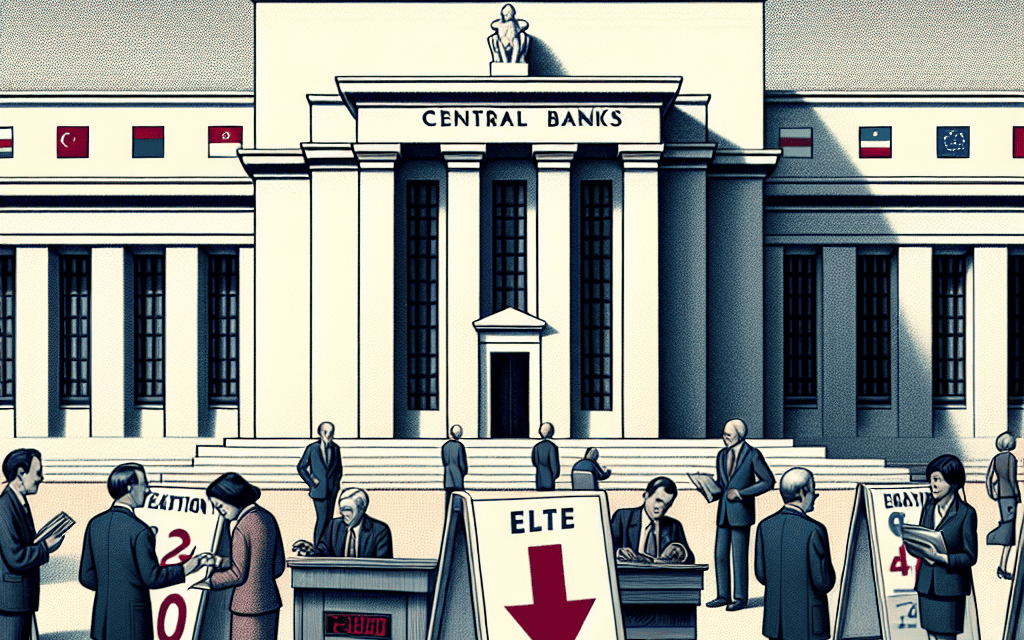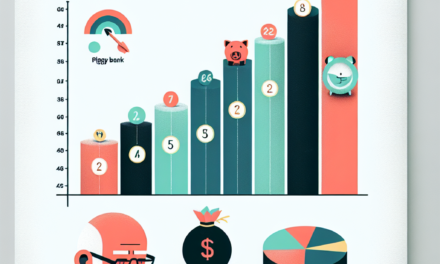“Post-Election Relief: Central Banks Poised to Ease Financial Strain with Rate Cuts”
Introduction
Following a pivotal election week, central banks around the globe are poised to implement interest rate cuts, signaling a strategic shift in monetary policy aimed at stimulating economic growth. This move comes as policymakers respond to evolving economic landscapes and the outcomes of recent political events, which have reshaped fiscal priorities and market expectations. The anticipated rate cuts are designed to lower borrowing costs, encourage investment, and boost consumer spending, thereby fostering a more favorable environment for economic recovery and stability. As central banks navigate the complexities of post-election economic conditions, their decisions will be closely monitored by investors, businesses, and governments, all keen to understand the implications for global financial markets and economic trajectories.
Impact Of Election Results On Central Bank Policies
The recent election week has ushered in a wave of anticipation and speculation regarding the future direction of central bank policies, particularly concerning interest rate adjustments. As the dust settles from the electoral outcomes, central banks are poised to implement rate cuts, a move that is expected to have significant implications for both domestic and global economies. This decision is not made in isolation but is rather a response to a confluence of factors that have been accentuated by the election results.
To begin with, the election outcomes have provided a clearer picture of the political landscape, which in turn influences economic policy directions. With new administrations or continued leadership, there is often a shift in fiscal policies that can either stimulate or dampen economic growth. Central banks, in their mandate to maintain economic stability, must adapt to these changes. The recent elections have signaled a potential for increased government spending in certain regions, aimed at boosting economic recovery post-pandemic. Consequently, central banks are considering rate cuts as a means to complement these fiscal measures, ensuring that borrowing costs remain low and accessible, thereby encouraging investment and consumption.
Moreover, the global economic environment remains fraught with uncertainties, including geopolitical tensions and supply chain disruptions. These factors have contributed to inflationary pressures, which central banks have been grappling with over the past year. However, the election results have brought about a renewed focus on economic growth, with policymakers prioritizing measures that can sustain recovery momentum. By implementing rate cuts, central banks aim to mitigate the adverse effects of external shocks and provide a buffer against potential economic slowdowns.
In addition, the labor market dynamics have also played a crucial role in shaping central bank policies post-election. With many economies still recovering from the pandemic-induced job losses, there is a concerted effort to achieve full employment. Lower interest rates can stimulate business expansion and hiring, thus supporting labor market recovery. The election results have underscored the importance of job creation as a key policy objective, prompting central banks to align their monetary policies accordingly.
Furthermore, the financial markets have reacted to the election outcomes with a mix of optimism and caution. While some sectors have experienced a boost in investor confidence, others remain wary of potential regulatory changes. Central banks, by signaling rate cuts, aim to provide reassurance to the markets, fostering a stable financial environment that can accommodate both growth and innovation. This move is also intended to prevent excessive market volatility, which can undermine economic stability.
In conclusion, the election results have set the stage for central banks to implement rate cuts, a decision driven by the need to support economic recovery, address inflationary pressures, and stabilize financial markets. As these institutions navigate the post-election landscape, their policies will be crucial in shaping the trajectory of economic growth. The interplay between fiscal and monetary policies will be pivotal in determining the effectiveness of these rate cuts, as central banks strive to balance the dual objectives of fostering growth and maintaining stability. As such, the coming months will be critical in assessing the impact of these policy shifts on both national and global scales.
Economic Indicators Influencing Rate Cuts
In the wake of a significant election week, central banks around the globe are poised to implement rate cuts, a decision influenced by a myriad of economic indicators. The political landscape often plays a crucial role in shaping economic policies, and the recent elections have underscored the need for monetary adjustments. As governments transition and new policies are anticipated, central banks are keenly observing economic indicators that suggest a need for easing monetary conditions to foster economic stability and growth.
One of the primary indicators influencing the decision to cut rates is the current state of inflation. In many economies, inflation rates have been fluctuating, with some experiencing higher-than-expected levels due to supply chain disruptions and increased consumer demand. Central banks aim to manage inflation by adjusting interest rates, and a rate cut could help stimulate spending and investment, thereby supporting economic growth. Moreover, the labor market’s performance is another critical factor. While some regions have seen improvements in employment figures, others continue to grapple with high unemployment rates. By reducing interest rates, central banks hope to encourage businesses to expand and hire more workers, thus bolstering the labor market.
Additionally, global trade dynamics have been a significant consideration. The recent elections have brought about changes in trade policies and international relations, which could impact export and import activities. Central banks are wary of potential trade disruptions that could hinder economic progress. By implementing rate cuts, they aim to provide a buffer against any adverse effects on trade, ensuring that domestic economies remain resilient in the face of global uncertainties.
Furthermore, consumer confidence is a vital indicator that central banks monitor closely. The political climate can significantly influence consumer sentiment, and the aftermath of elections often brings about a period of uncertainty. A rate cut could serve as a signal of stability, encouraging consumers to maintain or increase their spending levels. This, in turn, would support businesses and contribute to overall economic vitality.
In addition to these factors, central banks are also considering the impact of technological advancements and digital currencies on the financial landscape. The rapid evolution of technology has introduced new challenges and opportunities for monetary policy. As digital currencies gain traction, central banks are exploring how these innovations might affect traditional banking systems and the broader economy. A rate cut could be part of a broader strategy to adapt to these changes, ensuring that monetary policy remains effective in a rapidly evolving environment.
Moreover, geopolitical tensions and their potential economic repercussions cannot be overlooked. The elections have highlighted various geopolitical issues that could influence economic stability. Central banks are mindful of these risks and are prepared to adjust interest rates to mitigate any negative impacts on their economies. By doing so, they aim to maintain a balance between fostering growth and ensuring financial stability.
In conclusion, the decision by central banks to implement rate cuts following election week is driven by a complex interplay of economic indicators. Inflation, labor market conditions, global trade dynamics, consumer confidence, technological advancements, and geopolitical tensions all play a role in shaping monetary policy. As central banks navigate these challenges, their primary objective remains to support economic growth while maintaining stability in an ever-changing global landscape. Through careful analysis and strategic rate adjustments, they seek to create an environment conducive to sustainable economic development.
Historical Analysis Of Post-Election Rate Adjustments
In the wake of election week, central banks around the world are poised to implement rate cuts, a move that has historical precedence and significant implications for global economies. Historically, post-election periods have often been characterized by economic uncertainty, prompting central banks to adjust monetary policies to stabilize markets and foster economic growth. This pattern of rate adjustments following elections is not a novel phenomenon; rather, it is a strategic response that has been observed across various economic landscapes and political contexts.
To understand the rationale behind these post-election rate cuts, it is essential to examine the historical context in which they have occurred. Elections, by their very nature, introduce a degree of uncertainty into the economic environment. The anticipation of policy changes, shifts in government priorities, and potential regulatory adjustments can lead to market volatility. In response, central banks have historically utilized rate cuts as a tool to mitigate these uncertainties, aiming to reassure investors and stimulate economic activity.
For instance, in the aftermath of the 2008 financial crisis, several central banks, including the Federal Reserve in the United States and the European Central Bank, implemented rate cuts following election cycles. These measures were designed to inject liquidity into the financial system, encourage borrowing, and support economic recovery. Similarly, during the 2016 U.S. presidential election, the Federal Reserve maintained a cautious approach, eventually opting for rate cuts in subsequent months to address economic fluctuations and market reactions to the new administration’s policies.
Moreover, the decision to implement rate cuts post-election is often influenced by the prevailing economic conditions at the time. Central banks closely monitor indicators such as inflation rates, employment figures, and GDP growth to determine the appropriate course of action. In periods of economic slowdown or recession, rate cuts can serve as a catalyst for economic revitalization, lowering borrowing costs for businesses and consumers and encouraging spending and investment.
Transitioning to the present day, the current global economic landscape presents a unique set of challenges that central banks must navigate. The lingering effects of the COVID-19 pandemic, coupled with geopolitical tensions and supply chain disruptions, have created an environment of heightened economic uncertainty. In this context, the anticipated rate cuts following election week are seen as a proactive measure to address these challenges and support economic stability.
Furthermore, the implementation of rate cuts is not without its critics. Some economists argue that excessively low interest rates can lead to asset bubbles and financial imbalances, potentially undermining long-term economic stability. However, central banks often weigh these concerns against the immediate need to bolster economic growth and maintain market confidence.
In conclusion, the historical analysis of post-election rate adjustments reveals a consistent pattern of central banks utilizing rate cuts as a strategic tool to address economic uncertainties and promote stability. As we move forward, the decisions made by central banks in the coming weeks will be closely scrutinized, with their actions likely to have far-reaching implications for global economies. By understanding the historical context and rationale behind these rate adjustments, we gain valuable insights into the complex interplay between politics, economics, and monetary policy.
Global Reactions To Central Bank Rate Decisions

In the wake of a tumultuous election week, central banks around the globe are poised to implement rate cuts, a move that has garnered significant attention from financial markets and policymakers alike. This decision comes as a response to the economic uncertainties that have been exacerbated by political shifts and the ongoing challenges posed by global economic conditions. As central banks prepare to adjust their monetary policies, the world watches closely, anticipating the potential impacts on both domestic and international economic landscapes.
The rationale behind these anticipated rate cuts is multifaceted. Primarily, central banks aim to stimulate economic growth by making borrowing cheaper, thereby encouraging investment and consumer spending. In the aftermath of election week, which often brings about a period of uncertainty and volatility, such measures are deemed necessary to stabilize economies and instill confidence among investors and consumers. Moreover, with inflation rates in many countries remaining below target levels, central banks see an opportunity to bolster economic activity without the immediate risk of overheating.
Transitioning to the global stage, the reactions to these impending rate cuts are varied, reflecting the diverse economic conditions and priorities of different regions. In developed economies, where growth has been sluggish and inflation persistently low, the move is largely welcomed. Financial markets in these regions have responded positively, with stock indices experiencing a boost as investors anticipate a more favorable borrowing environment. Additionally, businesses in these economies are likely to benefit from lower financing costs, potentially leading to increased capital expenditure and expansion efforts.
Conversely, in emerging markets, the response is more cautious. While lower interest rates in developed countries can lead to capital inflows into emerging markets, seeking higher returns, there is also the risk of currency depreciation and capital flight if investors perceive these economies as unstable. Consequently, central banks in emerging markets may face a delicate balancing act, needing to weigh the benefits of attracting foreign investment against the potential downsides of increased volatility in their financial systems.
Furthermore, the global interconnectedness of economies means that the actions of major central banks, such as the Federal Reserve, the European Central Bank, and the Bank of Japan, have far-reaching implications. Their decisions to cut rates can influence global trade dynamics, affect exchange rates, and alter the flow of international capital. As such, policymakers worldwide are closely monitoring these developments, ready to adjust their own strategies in response to the shifting economic landscape.
In addition to the immediate economic impacts, the anticipated rate cuts also raise questions about the long-term implications for monetary policy. With interest rates already at historically low levels in many countries, central banks have limited room to maneuver in the event of future economic downturns. This situation underscores the importance of exploring alternative policy tools and strategies to ensure economic stability in the years to come.
In conclusion, as central banks prepare to implement rate cuts following election week, the global reactions are a testament to the complex interplay of economic forces at work. While the immediate goal is to foster growth and stability, the broader implications of these decisions will continue to unfold, shaping the economic landscape for the foreseeable future. As such, stakeholders across the globe remain vigilant, ready to adapt to the evolving challenges and opportunities that lie ahead.
Sectoral Benefits Of Lower Interest Rates
Following a tumultuous election week, central banks around the world are poised to implement rate cuts, a move that is expected to have significant implications across various sectors. As policymakers aim to stimulate economic growth and stabilize financial markets, the anticipated reduction in interest rates is likely to yield a range of benefits, particularly for industries sensitive to borrowing costs. Understanding these sectoral benefits is crucial for stakeholders seeking to navigate the evolving economic landscape.
To begin with, the housing market stands to gain considerably from lower interest rates. Reduced borrowing costs make mortgages more affordable, thereby encouraging homebuyers to enter the market. This increased demand can lead to a rise in home sales and, consequently, a boost in construction activity. Homebuilders and real estate developers are likely to experience heightened activity, as lower rates can also facilitate refinancing opportunities for existing homeowners, freeing up disposable income and potentially leading to increased consumer spending.
In addition to the housing sector, the automotive industry is another area that could benefit from rate cuts. Lower interest rates typically translate into more attractive financing options for car buyers, which can stimulate demand for new vehicles. As consumers find it easier to finance car purchases, automakers may see an uptick in sales, thereby supporting production levels and potentially leading to job creation within the industry. Moreover, the ripple effects of increased automotive sales can extend to related sectors, such as parts suppliers and service providers, further amplifying the economic impact.
Furthermore, the business sector, particularly small and medium-sized enterprises (SMEs), is likely to experience positive effects from reduced interest rates. Access to cheaper credit can enable these businesses to invest in expansion, innovation, and workforce development. By lowering the cost of borrowing, central banks can help SMEs overcome financial constraints, allowing them to pursue growth opportunities that may have been previously unattainable. This, in turn, can lead to increased competitiveness and productivity within the broader economy.
Moreover, the stock market often reacts favorably to interest rate cuts, as lower rates can enhance corporate profitability. With reduced borrowing costs, companies can improve their balance sheets and allocate more resources toward strategic initiatives, such as research and development or mergers and acquisitions. Investors, anticipating improved earnings prospects, may drive up stock prices, thereby boosting market confidence and potentially attracting further investment.
While the benefits of lower interest rates are evident across various sectors, it is important to consider potential challenges that may arise. For instance, prolonged periods of low rates can lead to asset bubbles, as investors seek higher returns in riskier markets. Additionally, savers may face diminished returns on deposits, which could impact consumer spending in the long term. Therefore, central banks must carefully balance the need for economic stimulus with the potential risks associated with sustained low interest rates.
In conclusion, the anticipated rate cuts by central banks following election week are poised to deliver a range of sectoral benefits, particularly for industries sensitive to borrowing costs. From the housing and automotive markets to small businesses and the stock market, lower interest rates can stimulate economic activity and foster growth. However, it is essential for policymakers to remain vigilant and address any emerging challenges to ensure that the benefits of rate cuts are maximized while minimizing potential risks. As the global economy continues to evolve, stakeholders must stay informed and adaptable to navigate the opportunities and challenges that lie ahead.
Challenges Faced By Central Banks In Timing Rate Cuts
In the wake of election week, central banks around the world are poised to implement rate cuts, a decision that is fraught with challenges and complexities. The timing of these rate cuts is critical, as central banks must carefully balance the need to stimulate economic growth with the risk of exacerbating inflationary pressures. This delicate balancing act is further complicated by the political and economic uncertainties that often accompany election periods, making the task of central banks even more daunting.
One of the primary challenges faced by central banks in timing rate cuts is the need to accurately assess the current economic landscape. Economic indicators such as inflation rates, unemployment figures, and GDP growth must be meticulously analyzed to determine the appropriate course of action. However, these indicators can be volatile and subject to rapid change, particularly in the aftermath of elections, when new policies and government priorities may be introduced. Consequently, central banks must remain agile and responsive, ready to adjust their strategies as new data becomes available.
Moreover, central banks must also consider the potential impact of rate cuts on financial markets. Lowering interest rates can lead to increased borrowing and spending, which can stimulate economic growth. However, it can also result in asset bubbles and increased risk-taking by investors, potentially destabilizing financial markets. Central banks must therefore weigh the benefits of rate cuts against the potential risks to financial stability, a task that requires careful judgment and foresight.
In addition to economic considerations, central banks must also navigate the political landscape. Election outcomes can lead to shifts in government policy, which may influence central bank decisions. For instance, a newly elected government may prioritize fiscal stimulus measures, reducing the need for aggressive monetary policy actions. Conversely, a government focused on austerity may necessitate more accommodative monetary policies to support economic growth. Central banks must therefore remain independent and objective, ensuring that their decisions are based on economic fundamentals rather than political pressures.
Furthermore, the global nature of modern economies means that central banks must also consider international factors when timing rate cuts. Economic conditions in major trading partners, exchange rate fluctuations, and global financial market trends can all influence domestic economic performance. As such, central banks must adopt a holistic approach, taking into account both domestic and international factors when making policy decisions.
Communication is another critical challenge for central banks. Clear and transparent communication is essential to manage market expectations and maintain credibility. Central banks must effectively convey their rationale for rate cuts, as well as their future policy intentions, to ensure that markets and the public understand their actions. This requires a delicate balance between providing sufficient information to guide expectations and maintaining the flexibility to adapt to changing economic conditions.
In conclusion, the timing of rate cuts by central banks following election week is a complex and multifaceted challenge. Central banks must carefully assess economic indicators, consider the potential impact on financial markets, navigate political dynamics, and account for international factors. Effective communication is also essential to ensure that their actions are understood and accepted by markets and the public. As central banks prepare to implement rate cuts, they must remain vigilant and adaptable, ready to respond to the ever-evolving economic landscape.
Future Projections For Monetary Policy Post-Election
In the wake of a highly anticipated election week, central banks around the globe are poised to implement a series of rate cuts, a move that has been the subject of much speculation among economists and financial analysts. This decision comes as part of a broader strategy to stimulate economic growth and stabilize financial markets, which have been experiencing heightened volatility due to political uncertainties. As the dust settles from the electoral process, central banks are now shifting their focus towards monetary policy adjustments that could have far-reaching implications for both domestic and international economies.
To understand the rationale behind these impending rate cuts, it is essential to consider the current economic landscape. Many countries have been grappling with sluggish growth rates, exacerbated by geopolitical tensions and trade disputes. In this context, central banks are under pressure to adopt measures that can invigorate economic activity. Lowering interest rates is a conventional tool used to encourage borrowing and investment, thereby boosting consumer spending and business expansion. By making credit more accessible, central banks aim to inject liquidity into the economy, fostering an environment conducive to growth.
Moreover, the timing of these rate cuts is particularly significant. Post-election periods often bring about a degree of uncertainty as new policies and leadership transitions take shape. In such times, financial markets can become jittery, leading to fluctuations in stock prices and currency values. By signaling a commitment to supportive monetary policy, central banks can help to reassure investors and stabilize markets. This, in turn, can mitigate the risk of economic downturns and create a more predictable financial environment.
However, the decision to cut rates is not without its challenges and potential drawbacks. Critics argue that excessively low interest rates can lead to asset bubbles, as investors seek higher returns in riskier markets. Additionally, prolonged periods of low rates can erode the profitability of banks, which rely on the spread between lending and deposit rates. Central banks must therefore strike a delicate balance, ensuring that their actions do not inadvertently sow the seeds of future financial instability.
Furthermore, the global nature of today’s economy means that the actions of one central bank can have ripple effects across borders. Coordinated efforts among central banks may be necessary to prevent competitive devaluations and ensure that rate cuts achieve their intended outcomes. International cooperation can help to align monetary policies, reducing the risk of adverse spillovers and fostering a more harmonious global economic environment.
As central banks prepare to implement these rate cuts, it is crucial for policymakers to remain vigilant and responsive to changing economic conditions. Continuous monitoring and assessment will be key to determining the effectiveness of these measures and making necessary adjustments. In this dynamic landscape, flexibility and adaptability will be essential attributes for central banks as they navigate the complexities of post-election monetary policy.
In conclusion, the anticipated rate cuts by central banks following election week represent a strategic response to current economic challenges. By lowering interest rates, central banks aim to stimulate growth, stabilize markets, and provide a buffer against potential downturns. While this approach carries certain risks, careful management and international collaboration can help to maximize its benefits. As the world watches these developments unfold, the actions of central banks will undoubtedly play a pivotal role in shaping the future trajectory of the global economy.
Q&A
1. **What is the role of central banks in the economy?**
Central banks manage a country’s currency, money supply, and interest rates, aiming to maintain economic stability and growth.
2. **Why might central banks consider rate cuts following an election week?**
Rate cuts may be considered to stimulate economic growth, especially if post-election uncertainty or policies impact economic confidence or activity.
3. **How do interest rate cuts affect the economy?**
Lower interest rates reduce borrowing costs, encourage spending and investment, and can boost economic activity.
4. **Which central banks are likely to implement rate cuts after election week?**
This depends on the specific economic conditions and policies of each country, but central banks in economies facing slow growth or recession risks might consider cuts.
5. **What are the potential risks of cutting interest rates?**
Risks include inflationary pressures, asset bubbles, and reduced effectiveness of monetary policy if rates are already low.
6. **How do elections influence central bank decisions?**
Elections can lead to policy changes, economic uncertainty, and shifts in market expectations, influencing central bank strategies.
7. **What other tools do central banks have besides rate cuts?**
Central banks can use quantitative easing, forward guidance, and reserve requirement adjustments to influence the economy.
Conclusion
Following election week, central banks are poised to implement rate cuts, signaling a strategic shift in monetary policy aimed at stimulating economic growth. This decision likely reflects a response to evolving economic conditions, such as slowing growth or geopolitical uncertainties, which necessitate a more accommodative stance to support financial stability and encourage investment. By reducing interest rates, central banks aim to lower borrowing costs, boost consumer spending, and enhance business investment, thereby fostering a more favorable economic environment. However, this approach also carries potential risks, such as increased inflationary pressures and reduced policy space for future economic downturns. Overall, the anticipated rate cuts underscore the central banks’ commitment to sustaining economic momentum and addressing emerging challenges in the post-election landscape.





